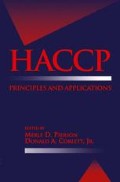Abstract
The activity of monitoring within a HACCP system is essential to the system’s success. In order to establish and effectively conduct monitoring procedures, the questions what, why, how, where, who and when must be answered.
Access this chapter
Tax calculation will be finalised at checkout
Purchases are for personal use only
Preview
Unable to display preview. Download preview PDF.
References
Anonymous. 1990. The tools of quality. Part V. Check sheets. In Quality Progress. American Society for Quality Control, Milwaukee, WI. Oct.
Eilers, J. 1991. Computer monitoring yields optimum CIP system performance efficiency. Food Processing 52(2)
U.S. Food & Drug Administration, U.S. Dept. of Health & Human Services (FDA/NOAA). 1990. HACCP based plan submission guide. Washington, DC, Sept. 11.
International Commission on Microbiological Specifications for Food (ICMSF). 1988. Microorganisms in Foods. 4. Application of the Hazard Analysis Critical Control Point (HACCP) System to Ensure Microbiological Safety and Quality. Blackwell Scientific Publications, London.
Jarvis, G. 1990. HACCP, monitoring and statistics. In Be Safe with HACCP—The Critical Component of a QA System. B.C. Food Technology Centre, Industry Development Group, B.C. Research, Vancouver, British Columbia. August.
Larusson, T., Balaban, M., Otwell, S., and Yeralan, S. 1991. Application of computer vision to seafood quality evaluation. In Proceedings of the Fifteenth Annual Tropical and Subtropical Fisheries Technological Conference of the Americas. Sea Grant College Program, Univ. of Florida, Gainesville, FL. In press.
National Academy of Sciences (NAS). 1985. An Evaluation of the Role of Microbiological Criteria for Foods and Food Ingredients. National Academy Press, Washington, DC.
National Marine Fisheries Service (NMFS). 1989. HACCP regulatory model for cooked shrimp. Report of the Model Seafood Surveillance Project, National Oceanic and Atmospheric Administration, NMFS, Office of Trade and Industry Services, National Seafood Inspection Laboratory, Pascagoula, MS.
Nickelson, R. II. 1978. Food contact surfaces—indices of sanitation. In Sanitation Notebook for the Seafood Industry. VPI SG-78-05. U.S. Dept. of Commerce, National Sea Grant College Program, Washington, DC.
Nolan, K. 1990. Planning a control chart. In Quality Progress. American Society for Quality Control, Milwaukee, WI. Dec.
Rosander, A. 1985. Application of Quality Control in the Service Industries. American Society for Quality Control, Milwaukee, WI.
National Advisory Committee on Microbiological Criteria for Foods (NACMCF). 1990. HACCP Principles for Food Production. USDA-FSIS Information Office, Washington, DC.
Editor information
Editors and Affiliations
Rights and permissions
Copyright information
© 1992 Van Nostrand Reinhold
About this chapter
Cite this chapter
Hudak-Roos, M., Garrett, E.S. (1992). Monitoring Critical Control Point Critical Limits. In: Pierson, M.D., Corlett, D.A. (eds) HACCP. Springer, Boston, MA. https://doi.org/10.1007/978-1-4684-8818-0_7
Download citation
DOI: https://doi.org/10.1007/978-1-4684-8818-0_7
Publisher Name: Springer, Boston, MA
Print ISBN: 978-1-4684-8820-3
Online ISBN: 978-1-4684-8818-0
eBook Packages: Springer Book Archive

